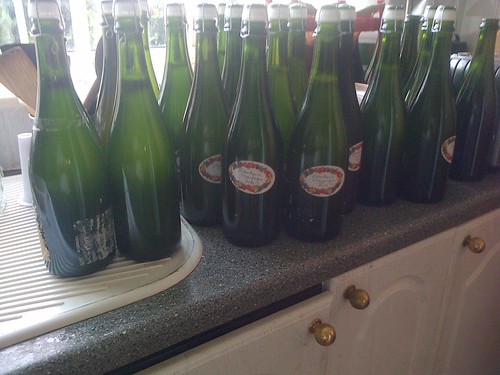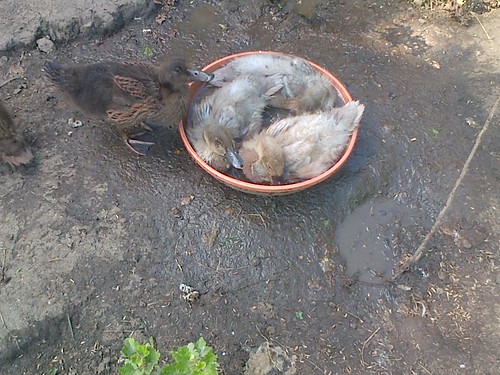We grow our own food in a suburban village in the North East of England. Follow us as we keep up the battle to be self-sufficient.
Tuesday 30 July 2013
Brooding hen
I have reported recently that one of our hens became broody. This video shows how we introduced some eggs for her to incubate. Alas, though setting her up with the eggs was straightforward, we made a huge mistake by trying to move her and the eggs a week before hatching was due. The result was the eggs never hatched.
Monday 29 July 2013
Point of lay
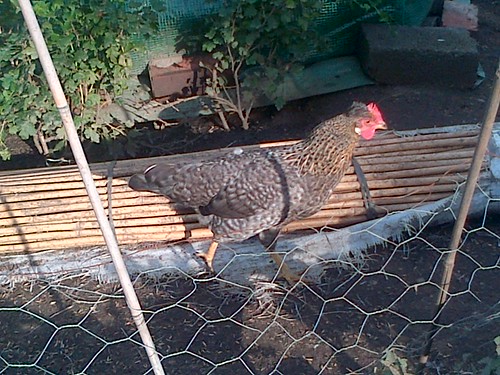
The hen in the above photo is one of the chicks we hatched in March. They are cream legbars and the four we kept are all in good shape. The cockerel is the most developed but the hen in the photo is coming along well. Her comb and wattles are developing well, a sure sign that she is approaching maturity and will soon be starting to lay. I'm rather looking forward to that.
Elderflower champagne
The goat pen

50 fence posts were delivered to my house today. They are for the goat pen we are about to build. The photo above shows the land where the pen will go. As you can see it is rather overgrown and hasn't been used for many years. We are aiming to get two nanny goats but first the fencing and the shed need to be built and the site fully secured. The site is traingular shaped with two long sides and one shorter one. There are well established hawthorn hedges along one long and the short side, making containment of the goats easier. Nevertheless this is going to be a huge job but I am hoping to have the site ready fro September when we will buy the goats. Then I have to learn to milk them!
Sunday 28 July 2013
Egg failure
My copper black hen Houdini went broody a few weeks ago, we ordered her 6 eggs to incubate. I was rather excited by the prospect of a hen escorting her chicks around the allotment. Alas, the experiment failed. We made the mistake of putting the eggs in a nest box in one of the henhouses. It turned out to be too busy. One egg disappeared, another was broken. So with a week to go before hatching was due, we took Houdini and her eggs out of the henhouse and to the backgarden where we put them all into a box. Within half an hour she had gone missing and we had to switch on the incubator as an emergency measure.
Houdini turned up the next day wandering around the lane at the back of the house. I returned her to the allotment. The eggs in the incubator unfortunately never hatched. Lessons have been learnt - if we want to try this again, we need a special nest box and run in the back garden where the hen will not be disturbed by others.
Houdini turned up the next day wandering around the lane at the back of the house. I returned her to the allotment. The eggs in the incubator unfortunately never hatched. Lessons have been learnt - if we want to try this again, we need a special nest box and run in the back garden where the hen will not be disturbed by others.
Rain at last
We have had a very long run of dry weather. We have been enduring (or enjoying, depending on point of view) a heatwave over recent weeks. The ground has been tinder dry for some time and for weeks I have been taking water over to the allotment three of four times a day. And then, last night, came the deluge. I reckon we had about 10cm of rain. The water butts are refilled, the pond has been topped up and the upright wheelbarrows were filled to the brim. The water was desperately needed. Hopefully the vegetables and fruit trees will feel the benefit.
Friday 26 July 2013
How to capture a bee swarm
We had three swarms in June. In this video I capture one of them using our swarm box. Of the three swarms, unfortunately one flew off as I was trying to capture it. The other two were caught and put into hives. One is doing well but the other (the one captured in this video) is not so strong and we may merge it with another.
Invasion of the polytunnel no. 2
I'm not quite sure how they did it but for the second time I found the ducks in one of the polytunnels. They got in on Wednesday and did quite a bit of damage to the courgette plants. The tomatoes came off better though not unscathed. This is the second time the ducks have managed to get into the polytunnel and the courgettes had only just recovered from the first invasion. I was however beginning to think it was a mistake to put the courgettes in with the tomatoes as they were being completely overshadowed by them. So yesterday I dug out what was left of the courgettes and transplanted them into the raised bed that is protected from invasion by a net over a frame. They seemed to be okay this morning. The ground there however is bone dry. The heatwave has no end in sight and though the rest of the country has had some decent amounts of rainfall, we haven't. It will mean we will have to add this raised bed to our watering rota.
Thursday 25 July 2013
After dinner speaker
This was a first for me. Tonight I was an after dinner speaker! I was invited to talk to the Whickham Rotary Club about self-sufficiency, bee-keeping, raising hens and growing vegetables. It was an interesting evening and a great group of people who grilled me at the end in a Q&A session about allotments, beekeeping, sloe gin and community based food growing.
Tbis was not the only meeting recently to which I was invited to talk about allotments and food growing. Yesterday I went to the Gateshead Central Nursery at the invite of the environmental charity Groundwork who have taken over the site for five years. The Nursery was previously used to supply the borough with the plants for hundreds of flower beds and for the parks. The Council has now greatly reduced the number of flower beds and the reduced number of plants needed are now bought in. So the Nursery became surplus to requirements.
The person I met from Groundwork was Geoff Dawson and he wanted to hear my ideas for community uses of the site, with its polytunnels and greenhouses as well as outdoor growing spaces. We also discussed craft and local food markets, beekeeping and herb gardens.
Groundwork are keen to have community businesses on the site and are open to ideas. If you have any suggestions for how the site can be used, please contact him on Geoff.Dawson@groundwork.org.uk.
Tbis was not the only meeting recently to which I was invited to talk about allotments and food growing. Yesterday I went to the Gateshead Central Nursery at the invite of the environmental charity Groundwork who have taken over the site for five years. The Nursery was previously used to supply the borough with the plants for hundreds of flower beds and for the parks. The Council has now greatly reduced the number of flower beds and the reduced number of plants needed are now bought in. So the Nursery became surplus to requirements.
The person I met from Groundwork was Geoff Dawson and he wanted to hear my ideas for community uses of the site, with its polytunnels and greenhouses as well as outdoor growing spaces. We also discussed craft and local food markets, beekeeping and herb gardens.
Groundwork are keen to have community businesses on the site and are open to ideas. If you have any suggestions for how the site can be used, please contact him on Geoff.Dawson@groundwork.org.uk.
Wednesday 24 July 2013
How to make raspberry and gooseberry jam
We are now into jam-making season and last week I made raspberry and gooseberry jam. Raspberries are low in pectin, gooseberries are high so this was a good combination that set well.
Tuesday 23 July 2013
Rediscovering the pond
This afternoon, whilst picking raspberries in the fruitcage, I noticed the ducklings wander past and rediscover the pond. It was a few minutes before they had the courage to go into the water but when they did go in, they were like kids on holiday. And then the khaki campbell drake appeared and chased them away. I thought that would be the end of their visits to the pond but this evening I spotted them making a return trip. And they spent a good deal of time on the water and left of their own accord when they had had enough. Hopefully now they will spend less time lying in the water feeders and more time on the pond.
Lavendar bed
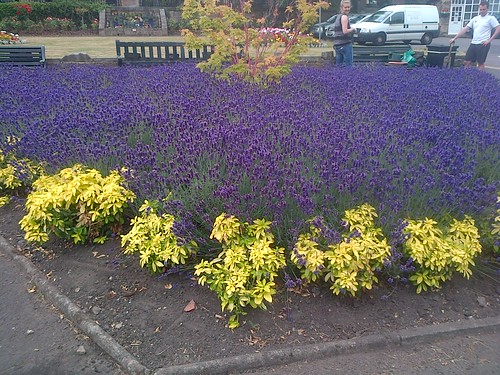
I took this photo this evening whilst helping volunteers do the final spruce up of Church Green in Whickham, near my home village of Sunniside on Tyneside. The Northumbria in Bloom judges arrive tomorrow. What caught my attention was that the lavendar was buzzing with bees - both honey and bumble. So if you want to be bee friendly as well as having a garden attractive to the human eye, plant lavendar.
Guest blog: How & What to Plant in Different Soil Types
I am happy to include guest blogs on Self-Sufficient in Suburbia. In this post, Jessie Wang writes about soil types. If you want to write a post for the blog about growing food, keeping an allotment or cooking the food you have grown, please email me on jonathanwallace@compuserve.com. Your post should be informative, relaxed in its style and fit the beliefs of the site: sustainability, local production, environmental protection and promotion of good health through growing and eating you own food.
I believe everyone can grow their own, no matter what soil type you have andeven if you are a beginner gardener!
How and What to Plant in Different Soil Types
I believe everyone can grow their own, no matter what soil type you have andeven if you are a beginner gardener!
If you are a beginner, you might be wondering where to start. So, in order to help you to start your self-efficient journey I’m going to help you understand the four most common soil types and the right fruits and vegetables for each.
Enjoy reading!
1. Acidic Soil
Acidic soil is soil that has a pH value below 7. This type of soil appears a lot in the regions with high precipitation. Since plants always prefer an acidic soil environment, you can grow almost anything here! This is because the acidity better dissolves the nutrients and minerals within the soil. However, the pH level of an ideal acidic soil should be between 5.5 and 7.0. If lower, it could be too acidic and harm the plant.
How to identify the soil type:
1. One easy way that everyone can do is using baking soda. Give some liquidity to the mud by mixing dry dirt and distilled water. Then put baking soda onto the mixture. If you see bubbles, it means it is acidic.
2. Otherwise, buy a soil pH test kit. If it shows between 5.5 and 7, it’s great!
What to grow and what to bear in mind:
It’s summer now, and we all love strawberries. The good news is that strawberries are one of the best choices for acidic soil! They prefer this type of soil environment and will naturally thrive. Otherwise, blueberries, carrots, garlic, sweet peppers, tomatoes, squash and pumpkins are all great choices.
But, before you start your happy planting journey, here are some tips to remember for acidic soil. It would be wise to add some mulch in late autumn, so as to protect the plants’ bases from winter conditions as the roots of acid-loving plants are normally quite shallow. Also, take advantage of your used coffee grounds, or go ask the local coffee shop for them if you aren’t a big coffee drinker. Spread them over the soil three times a year for happy, healthy plants.
2. Chalky Soil
The colour of chalky soil is light brown to white. It contains many stones, normally chalky white stones, lime, and calcium carbonate. This soil is alkaline and free draining. Many people say that it’s not fertile land, however while that is true in many circumstances, when there is clay present too the nutrient levels would be higher and the soil may have a better water holding capacity. Chalky soil drains well and warms up fast in spring. It is also easy to cultivate in rainy season.
How to identify the soil type:
1. Use vinegar to test: this type of soil type is very easy to identify by pouring a little household vinegar onto it, since the calcium carbonate within the chalk will present itself when touching weak acids like vinegar. If the mixture fizzes, it is alkaline.
2. Use a soil test kit: The PH value of chalky soil is between 7.1 and 8.0.
What to grow and what to bear in mind:
Since chalky soil is alkaline, and cannot be acidified, it is better to choose plants that will thrive in alkaline conditions. Vegetables such as spinach, beets, sweetcorn, and cabbage, and fruits like pyrus, sorbus and arbutus will do well in chalky soils.
What you need to remember is that since chalky soil lack nutrients, using additives like fertiliser and compost is very necessary, as well as frequent watering in summer or on hot sunny days as chalky soil dries up easily.
3. Sandy Soil
As the name suggests, sandy soils contains a high proportion of sand and little clay. Sand particles are large enough to allow water to drain easily. However, it also means that it will dry out quickly. The rain will take away the nutrients so unsurprisingly, it is also called “hungry” soil!
How to identify the soil type:
1. By using your eyes and hands – sandy soil will not form distinct shapes, so an initial test can be trying to mould the soil into little balls. If it just crumbles away, even with water added,, there are high chances it’s sandy soil. Also, it is normally brown in colour.
2. Sandy soil is actually a little acidic. So using the baking powder or pH testing method as introduced in the Acidic Soil section can work. After you get the result, see and touch the soil according to method one, and you should be able to tell if it’s sandy or just regular acidic soil.
What to grow and what to bear in mind:
Ideal crops for growing in sandy soil include watermelons, peanuts and peaches. Sandy soil is light, easy to warm up, and easy to dry out, especially in spring and fall. Therefore, you should remember to add quality topsoil to your sandy soil in these two seasons. Also, it would be sensible to water and feed the soil a bit earlier in spring than you would otherwise.
4. Clay Soil
Typically, ‘clay’ soil is at least 25% clay. It is a quite nutritious and watery type of soil, because the nutrients get stuck to the clay minerals and there is little space between the clay particles, so it’s hard for the nutrients to get washed away by rainwater. It’s also known as “heavy soil”.
How to identify the soil type:
Feel it and play with it: Clay soil will crack and is rock-hard when dry, and lumpy and sticky when very wet. So you can try to roll it between your fingers - it should form into a shape fairly easy if it is wet. You should also be able to feel the very fine particles if you rub it between your thumb and forefinger.
What to grow and what to bear in mind:
While most vegetables will be suitable for clay soil, leafy vegetables, teas, beetroot, turnips and mooli would definitely grow well.
For clay soil the thing you need to remember is that unlike sandy soil, it drains quite slowly and will take longer to be warm up in spring. It’s also easy to crack in summer as mentioned above, so watering on a regular basis is necessary.
So now you understand the different soil types better, go to your garden and find out what soil type you have! Once you know, you can also use this plant finder tool (http://www.coblands.co.uk/knowledge-base/plant-finder) to see which flowers are suitable for your own garden.
About the Author: Jessie Wang is a freelance writer who blogs about gardening, education and leading an eco-friendly lifestyle. You can contact her by email: jessiewang0909@gmail.com.
Photos courtesy of USDA
Monday 22 July 2013
Raspberry and gooseberry jam
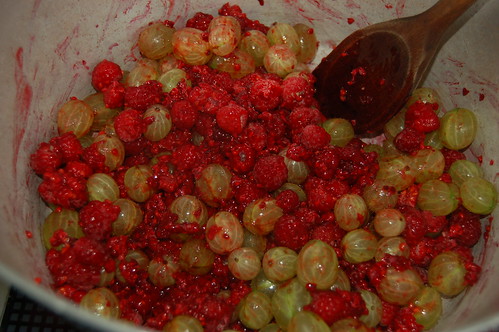
The jam making season is underway. Last week I made two lots - gooseberry and elderflower, and raspberry and gooseberry. As gooseberries contain lots of pectin, there was no need to add lemon juice. The quantities of each were not great - 3 jars of each. However, the raspberry crop is ready for picking and it looks like it is going to be a good quantity. There will be more jam making over the next few days.
The photo above was taken when making the raspberry and gooseberry jam. It is made from equal quantities of both. Sugar was the same weight as the total of fruit.
Our self-sufficient month approaches

We are planning to spend a month soon during which we will eat only the food we have grown ourselves, foraged for or traded for using our own food as currency. We do not have a specific start date yet but it is likely to be in early August. We are in what could be described as a transition stage at the moment in which we are switching to food mainly produced from our own sources. Yesterday, dinner was roast lamb (which we bought in January using some of our Tamworth pork), with potatoes and turnips from another allotment holder we bought using jam and honey. (See photo above.) A bit of honey was added to the turnips when they were cooked. The mint sauce was also made from our own mint.
Tonight we finished the vegetable and pheasant soup I made last week, the ingredients for which were all from our own sources.
I have a meeting tomorrow and I foolishly made a promise to make the lunch for all those attending. So they will be having Tamworth pork burgers, made by me.
I will be reporting on each day's food during the month but will also blog about how we are getting on in the run up to the month as well.
Elderflower vinegar
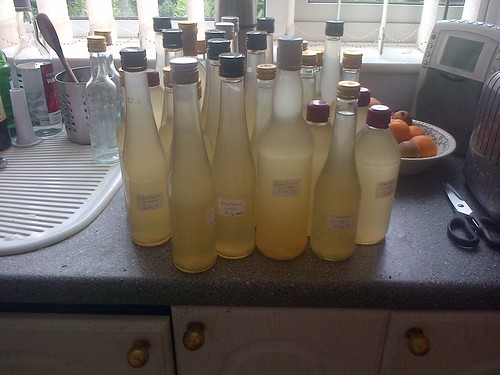
This was meant to be last year's elderflower champagne.Alas, when I set about making it, I made the mistake of leaving it in the fermenting bucket for too long with the result it started to turn to vinegar. Rather than throw it away, I decided it was better to let it turn fully to vinegar. After all, I use plenty of it in making pickles and chutneys. The vnegar has now been bottled up - I made 32 bottles though I put two into this year's elderflower champagne mix (the vinegar is needed to moderate the fermentation process.
Sunday 21 July 2013
Toads

I found a toad on the allotment yesterday. That in itself was not unusual - though it is the first I have found this year. I suspect their numbers on the plot are lower now due to the hens and ducks. It was only after letting it go that it occured to me that I should have put it into one of the polytunnels. It would have been safe from the hens and been in a warm and wet environment where it could have eaten any bugs that were helping themselves to my tomato plants. Great ideas always come too late.
Hidden eggs

Every summer I have the same problem. Some of my hens and ducks decide to find very well hidden places in the allotment to lay their eggs. Last week I found 14 under a tree. Yesterday I found the ones in the picture above under some branches in the drainage trench I have not yet finished filling with gravel. I reckon there are more eggs somewhere. The production figures are a bit low at the moment to suggest otherwise. However, a thorough weeding and search operation today turned up nothing. I'll have to keep searching.
Hive checks
We carried out a check on all our hives today. We have 10, two of which are new - they contain the two swarms I captured last month. Four hives have supers that are nearly full and could be taken off in the next two weeks. If they are anything like the super I took off one of the hives on Wednesday, they should each have about 15 kg of honey. So, in total, the honey crop will be 75kg by the start of August.
Two of the hives had given us cause for concern earlier this year. Both looked weak at the time but now both are strong. We added a super to one of them two weeks ago and that hive has nearly filled it. Today we added a super to the other one.
It wasn't all good news. One of the new swarm hives looks weak. One of last year's hives also looks odd inside - with drone but no worker brood. It may mean it has an infertile queen. These two hives may be candidates to merge with others.
Nevertheless, we are looking at a good crop of honey and with a bit of luck could get over 100kg by the end of the summer. The video above was filmed a couple of weeks ago. It shows our checking the hive from which we removed the honey last week.
Burning issues

I put the incinerator into operation on Saturday morning to burn the cardboard packaging from the polytunnels. Thcardboard was in reality used as kindling to burn some old hive frames, some of which contained old wax. The frames were in brooder boxes and supers we bought in a hive sale in April. Some of the frames were so old and worn out that they could have been infected so burning was the best solution. Alas, we also have to clear up after some scumbag selfish moron decided to dump a load of rubbish outside our allotment gate a few weeks ago. All the cardboard from this moron's new bathroom fittings went onto the incinerator as well. As the photo above shows, the bees wax assisted the incineration process.
Vegetable and pheasant soup
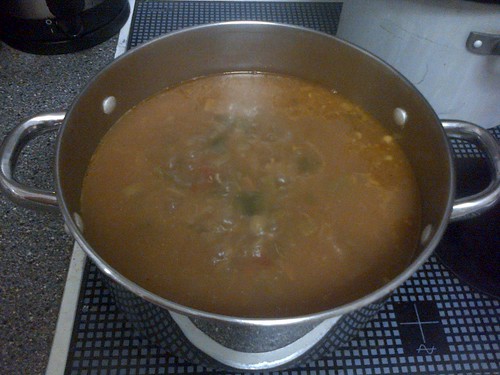
Making vegetable and pheasant soup was a useful way of clearning space in the freezer. The pheasant was left over from Xmas. The vegetable part was already made into a vegetable soup. It formed the base for the new soup. And some pheasant and pork bones in the freezer were used to make stock.
I know this isn't exactly the weather for hot soup but we were very grateful for the space freed up in the freezer!
Saturday 20 July 2013
Another polytunnel
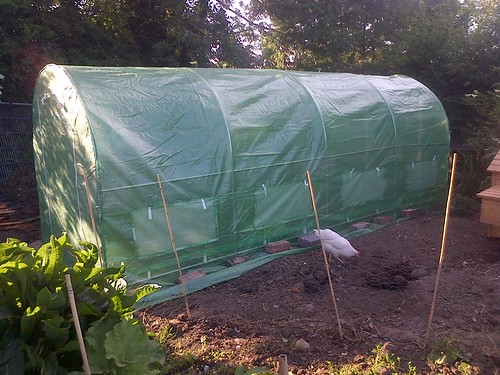
The second of the new polytunnels is now installed on the allotment. Today it was planted out with more tomatoes, courgettes, marrows and gherkins, all of which had previously been in the greenhouse. A few cos lettuces went in as well. The polytunnel was built on a part of the allotment not previously cultivated. The ground there needed a great deal of preparation. I spent a week digging out a layer of sand and gravel that a previous tenant of the allotment for some unknown reason had dumped there. Manure and mud and silt from the pond were also added to the ground as well.
The other polytunnel, built in June, is now packed full of tomatoes that seem to be thriving there. I also have courgettes and peppers in it, plus an interesting experiment in growing ginger. I bought some root ginger a few weeks ago, forgot about it for a while and rediscovered it in time to find it sprouting. So we planted it into a pot and put it in the polytunnel. Tonight I found a shoot growing. So hopefully soon, we will have our first ginger crop.
The heatwave continues
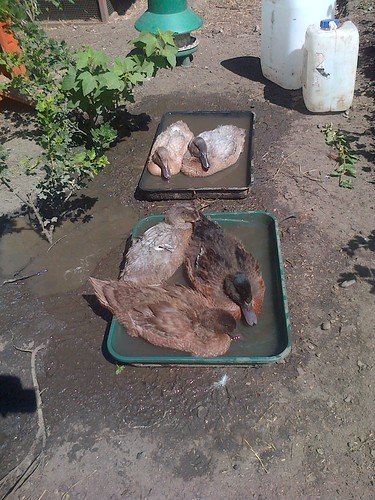
2011-12 saw a very mild winter followed by an incredibly wet spring and summer. And then in 2013, there was a very cold winter which vastly outstayed its welcome well into April. Now we are faced with a summer heatwave, the longest for 7 years. I shouldn't complain as this is ideal weather for the bees and a good honey crop would be very useful. Despite an unexpected bit of rain last night, we have had very little for a month. That means we are carrying water to the allotment 4 or 5 times a day. It nearly all goes to the hens and ducks or straight onto the crops in the greenhouse and polytunnels. To ensure we get decent veg crops we are going to have to water the outdoor beds as well.
The ducklings will not use the newly cleaned and enlarged pond. Instead, they lie in the water bowl before turning them into mud. At some point soon we will have to build a second pond for them.
Friday 19 July 2013
Ducklings - the first 6 weeks
I filmed this over a six week period after the ducklings hatched. Enjoy!
Thursday 18 July 2013
Strutting his stuff

This is the cockerel that was one of the seven chicks we hatched in March. His name is Malt Easter - it was chosen by kids at the Marley Hill craft market where we had a competition to come up with the best names for our chicks. He has grown at a remarkable pace and his comb and wattles are very impressive. I'm rather pleased with him. He's a beautiful bird and we are looking to show him. His first outing will be in September when he will be entered into the "best cockerel" competition at the Hurrocks Allotment Show in Swalwell, Gateshead.
He is, of course, already doing his stuff with the 19 hens. I even saw him taking on Atilla, one of the boss hens, this afternoon. When the hens from the batch of eggs from which he came start laying, we may hatch some of the eggs, though a final decision on that will be made in the future.
A fleeting appearance at the pond
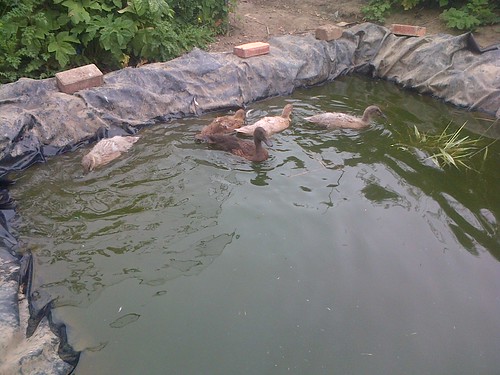
The duckings have, since I first brought them to the allotment, stayed of their own accord on the half of the plot that does not include the pond. You may recall that the pond was cleaned and extended in preparation for the arrival of the ducklings. Instead, they have used the water bowls as miniponds. To introduce them to the pond, last week I put the duckling house next to the pond and opened the door so that the ducklings came straight out onto the water. The ducklings as expected came out, went straight onto the pond, enjoyed themselves for a few minutes and then made a run for it back to their usual side of the allotment when the adults turned up.
They have not returned and it leaves me with a problem of ensuring they have an area of water for paddling, swimming, wading and generally making a mess. I have long term plans to put another pond on the allotment so I may have to bring this forward. Given the complete absence of any rain this month however, filling it is going to be something of a problem. I bring water to the allotment 3 or 4 times a day, nearly all of which is used for the poultry or the greenhouse and polytunnels. Digging a new pond in the middle of a heatwave is not exactly the best proposal I have come up with!
Well worth the wait!

It has been a long time in coming but at last, a honey crop has arrived. From just one hive today, I took 15 kg of honey in a super in which there were 10 full frames. This one hive has given me more than three times the entire honey crop we got last year. And there is more to come. I had a look at two other hives. The first has a super that is nearly full and will be ready to be gathered in next week.
The second hive was very weak earlier in the year and we were watching it carefully to see if it needed to be merged with another. Over the past few weeks we have watcehd as it grew stronger and more and more bees were flying in and out of it. 10 days ago, David put a super on it as we felt it was now strong enough to give us a honey crop. I had a quick look at it this afternoon and saw the super was full of bees and the comb was being drawn out.
The honey has been left in its honeycomb and put into 250g packs. We are running a community BBQ on Friday evening so the honey will go on sale then.
We will be doing a full check of the hives this weekend but it looks like we should get a reasonable honey crop this year.
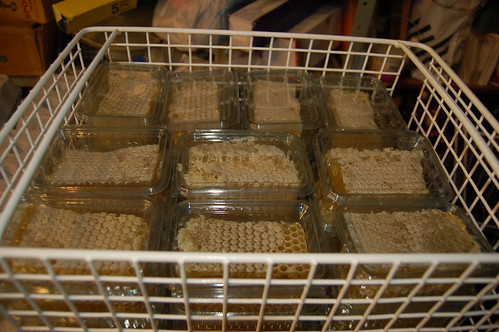
Wednesday 17 July 2013
Mixing it
I've been rather busy over the past week since getting back from London so apologies for the lack of posts recently. I will catch up as soon as possible. However, I thought I would share this with you tonight. The ducklings continue to grow at quite a pace so last week we took the decision that the little duckling house would have to be replaced over the weekend. Quite simply, the ducklings were growing so fast that there would be no room for all of them to fit in if they continued to use it much longer. So on Sunday we went to Durham Hens, bought a "lodge" henhouse (we have 2 already, one for the adult ducks and the other used as a henhouse) and assembled it.
The ducklings were put into it on Sunday evening. On Monday evening, much to my surprise, they made their own way into it. (Their parents needed to be funnelled into their duck house a few times before they learnt to go in of their own accord at sun down.) This evening, I saw some of the hens taking an interest in the new duckling house. When I went over to the allotment at 10.30pm to lock up, there were 6 hens in the duckling house, along with the five ducklings. They all seemed quite settled so I left them to it. If this arrangement becomes permanent, it means we have quite a bit of capacity in the other henhouses. We are hoping that 4 hen eggs we have in the incubator will hatch on Thursday (though I have some doubts any will hatch - more about that on another day). They will use some of the capacity though we won't be keeping any that are cockerels given we already have one (he was one of the chicks we hatched in March). So we may be on the lookout for more hens soon (though we got another on Sunday when at Durham Hens - again, more about that soon).
The ducklings were put into it on Sunday evening. On Monday evening, much to my surprise, they made their own way into it. (Their parents needed to be funnelled into their duck house a few times before they learnt to go in of their own accord at sun down.) This evening, I saw some of the hens taking an interest in the new duckling house. When I went over to the allotment at 10.30pm to lock up, there were 6 hens in the duckling house, along with the five ducklings. They all seemed quite settled so I left them to it. If this arrangement becomes permanent, it means we have quite a bit of capacity in the other henhouses. We are hoping that 4 hen eggs we have in the incubator will hatch on Thursday (though I have some doubts any will hatch - more about that on another day). They will use some of the capacity though we won't be keeping any that are cockerels given we already have one (he was one of the chicks we hatched in March). So we may be on the lookout for more hens soon (though we got another on Sunday when at Durham Hens - again, more about that soon).
Monday 8 July 2013
Late arrivals
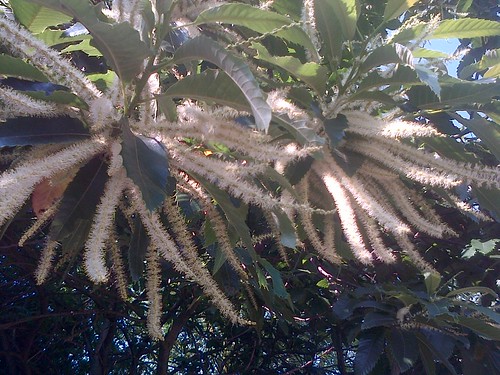
I am still in London and won't return home until Tuesday. My stay here has given me the chance to have a look at some of the trees that are normally a couple of weeks ahead of us in the North East. There are two in particular I was keen to see: sweet chestnut and cherry. Both are late because of the late end to winter. I am used to the growing season in the South East of England being a couple of weeks ahead of us in the North East. I am used to the sweet chestnuts having gone through the blossom stage by now. This year the trees are still in blossom. I noticed however that honey bees were very keen on them. (So if you are thinking of planting bee friendly trees that are productive, plant sweet chestnut.)
The cherry crop is normally over by now in both the South East and the North East. June is the month to pick this fruit. Leave it too long and the wood pigeons have helped themselves to the whole lot. Not so this year. We are at the start of the second week in July and in London the fruit is still ripening. And we are two weeks behind back home. Still, this is better than last year. We got virtually no cherries then. The weather then was only partly to blame. The cherry trees had lost most of their leaves by July as some kind of fungus was infecting them. This year, despite the late arrival of the crop, it is a much better picture than last year.
Whilst walking around the local park I spotted elderflower and bramble flowers. The elder normally finishes flowering in June. Again, another later runner. In recent years, the brambles have been getting earlier. My impression is that though they are a bit later this year, they have not suffered as much as other fruit producing bushes and trees.

Restoring the pond
Last week, the work on the pond on the allotment was completed. This was at times a messy and smelly job. Firstly I had to use a bucket to remove the water and then use the same bucket to remove the thick layer of mud from the bottom.

The sides were banked up to increase the depth and one side was extended further to increase the surface area.
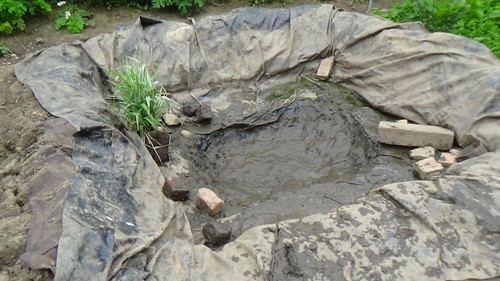
Had this been 2012, we would have filled the pond with rainwater. Since we have immaculately timed this to coincide with a period of dry weather and sun, we have had to fill the pond with mains water.
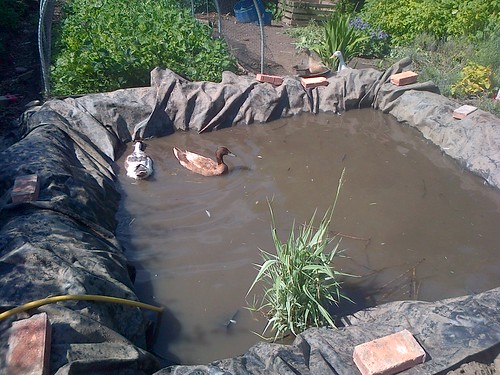
This picture was taken before the pond was fully filled (you can see the hose pipe bottom left) but already the ducks have rediscovered the pond. Alas, the ducklings are yet to find it. The pond was extended to ensure there was sufficient space for them but at the moment they are sticking to the other side of the allotment. I may have to help them discover it.

The sides were banked up to increase the depth and one side was extended further to increase the surface area.

Had this been 2012, we would have filled the pond with rainwater. Since we have immaculately timed this to coincide with a period of dry weather and sun, we have had to fill the pond with mains water.

This picture was taken before the pond was fully filled (you can see the hose pipe bottom left) but already the ducks have rediscovered the pond. Alas, the ducklings are yet to find it. The pond was extended to ensure there was sufficient space for them but at the moment they are sticking to the other side of the allotment. I may have to help them discover it.
The Smallholder and Self-Sufficiency Show
On Saturday I went to Ardingly in Sussex to go to the Smallholder and Self-Sufficiency Show. For someone like me, it was like being in heaven! Lots of information, useful tips, inspiration and ideas! The video gives a taste of the show though it covers mainly the livestock that was on display. This is an annual show but the first one I have attended. I suspect it won't be the last.
Friday 5 July 2013
Room for another?
Thursday 4 July 2013
How to make pork, apple and sage sausages

We bought another Tamworth pig last month from Bill Quay Community Farm in Gateshead and last week it went to slaughter. We picked up the meat from the farm on Saturday. When we bought our first pig, the slaughterhouse converted some of the sausagemeat into sausages. This time we asked them just to give us the sausagemeat so we could make the sausages ourselves. Earlier this year, we bought a sausage making machine which, up to now, had only been used as a mincer. Last night we put it through its paces to make pork, apple and sage sausages.
The recipe was:
- 1kg sausagemeat
- 150g rusk
- 3 apples, peeled and cored
- generous handful of finely chopped fresh sage
- 3 onions
- 75ml water
- 4 clovers of garlic
- 3g ground peppercorns
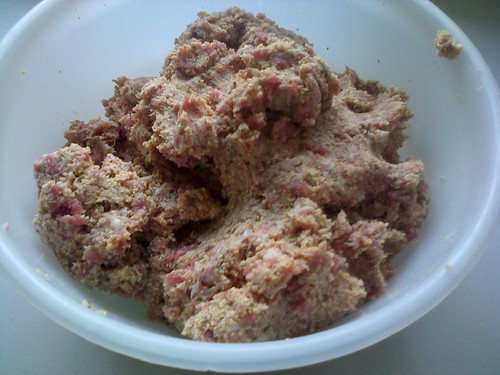
All the ingredients mixed together.

Before putting the sausagemeat mix into the casing, fry a small bit to test the taste.

The final product. Alas, we gave up using the sausage-making machine. Whilst it was fine for mincing, for stuffing the casing it was a waste of time. We spent an our stuffing about 40cm of casing before giving up on the machine. Instead, we took the nozzle off it and used it to hand fill the casing. It took a fraction of the time.
Giving Nature a Home
I have often mentioned the need to ensure wildlife and human life live side by side rather than in competition. Having for example amphibians on our allotment helps us to keep down the bugs. That's good for our crops. Hedgerows and grass verges in the area full of flowes are great for our honey bees. Having hedgehogs around is useful for eating slugs and snails that would otherwise eat our lettuces and cauliflowers. So, when the RSPB sent me the following article for circulation, I was quite happy to publish it on the blog.
Giving Nature a Home
The RSPB needs your help to give nature a home.
Earlier this year a group of 25 conservation and research organisations published The State of Nature report, which painted a picture of how well our wildlife was doing. Sadly, the news was not good with six out of 10 plants and animals in the UK having declined over the past five decades. These include hedgehogs, garden butterflies, bees, sparrows and starlings.
But while the UK’s wildlife is not in the best of shape, the good news is we can all do our bit to help it thrive once again. As part of its Giving Nature a Home campaign, The RSPB has come up with a list of loads of different things you can do in your garden to help wildlife.
If you are feeling lazy, then why not give your mower a rest and leave an area of your lawn to grow wild. This will provide homes for lots of bugs and mini-beasts, which in turn are great food for birds. Making logs piles and growing flowering plants are also easy ways to attract insects like bees, while the more adventurous of you might want to dig a pond or build a home for swifts, house martins or bats.
To find out more about how you can give nature a home visit www.rspb.org.uk/homes or call 01484-868405 to request a free guide.
Giving Nature a Home
The RSPB needs your help to give nature a home.
Earlier this year a group of 25 conservation and research organisations published The State of Nature report, which painted a picture of how well our wildlife was doing. Sadly, the news was not good with six out of 10 plants and animals in the UK having declined over the past five decades. These include hedgehogs, garden butterflies, bees, sparrows and starlings.
But while the UK’s wildlife is not in the best of shape, the good news is we can all do our bit to help it thrive once again. As part of its Giving Nature a Home campaign, The RSPB has come up with a list of loads of different things you can do in your garden to help wildlife.
If you are feeling lazy, then why not give your mower a rest and leave an area of your lawn to grow wild. This will provide homes for lots of bugs and mini-beasts, which in turn are great food for birds. Making logs piles and growing flowering plants are also easy ways to attract insects like bees, while the more adventurous of you might want to dig a pond or build a home for swifts, house martins or bats.
To find out more about how you can give nature a home visit www.rspb.org.uk/homes or call 01484-868405 to request a free guide.
Registering with DEFRA
We are expecting our plans to get goats to start taking shape this month. Yet getting goats is not simply a matter of buying the animals and housing them on the land we have arranged for them. The red tape of the state steps in at this point. The transportation of goats from one owner's site to another is an activity that is monitored and recorded by DEFRA, for good reason (disease control). There has to be a paper trail that proves the identity of the animal and its source. Whilst the red tape is an irritation, it is nevertheless necessary. So today I registered with DEFRA for a "County Parish Holding Number", which will be unique to me and identifies who I am and where I will be keeping my goats. I need the number before I can buy the goats as I have to give my number to the person selling the goats to me. It will take a few days before the number arrives and by then I am hoping we will be well on the way to preparing our site for the arrival of the animals
Ducklings on the allotment

On Monday I moved the ducklings from the temporary run in the back garden to the allotment. My expectation was that they would immediately bond with the ducks there - they are after all the parents of the duclings. Something similar happened last year when we bought 3 ducks and 5 ducklings. When we put them onto the allotment they immediately formed a close knit group. Alas, this was not the outcome. Instead, the parents rejected the ducklings and chased them away. The ducklings now stay clear of the adults. In effect we now have 2 groups on the allotment. This is not what we planned or expected.
The result is that the small hutch that served as a duck house in the back garden has had to be taken to the allotment as a continuing home for them. They will however outgrow it shortly and we will have to build an additional duck house.
Other than the rejection by their parents, the ducklings do seem to be thriving on the allotment. They stick closely together as a group but wander around the plot, carefully avoiding the older ducks. On Thursday, the work on the pond will be completed and I'm rather looking forward to their using it.
Tuesday 2 July 2013
Invasion of the polytunnel
The big polytunnel we put up recently was meant to keep the hens off our crops. On Sunday, something went wrong. When I arrived on the allotment in the afternoon, the five ducks and two of the hens were inside the polytunnel with no apparent way in. We think they got in under the flap that acts as a door. There are now more bricks placed on it to avoid a repeat. Alas, we had some damage though not as much as it could have been. The courgettes have been badly trampled but they can recover. A couple of pepper plants were damaged but not too badly. Some tomatoes were knocked over but we can stand them up again. Interestingly, they did a good job of weeding the polytunnel!
A brooding hen and 6 eggs

The exchequer leghorn white hatching eggs I ordered last week arrived on Friday and I took them over immediately to the hen house where Houdini, one of our copper blacks, was incubating any eggs she could find. The 6 eggs were added to the nest box and she has occupied the space ever since, except when heading out to eat. That appears to be when other hens sneek in and add an egg of their own to the haul. I have to check the nest a couple of times a day to remove them. None of my hens lay white eggs so spotting any intruders is easy. They are due to hatch on 18th-19th July.
Ducklings on parade

On Saturday, the Whickham Community Festival was held. I had a table selling my homemade jam and promoting the Allotment Cafe and craft market I run in Marley Hill Community Centre in the next village from ours. There was a medieval theme to the day and a medieval village "duck pond" (a kid's paddling pool) was created. I took down my ducklings to put in a cage next to the "pond" and they turned out to be one of the star attractions!
That wasn't their only outing. On Sunday, we took the ducklings to Marley Hill and put them in the cage on the grass outside the cafe. Whilst we were running the cafe, kids could look at the ducklings and enter a competition to name them. As yet we haven't chosen the winner. That's on my to-do list.
Subscribe to:
Posts (Atom)
